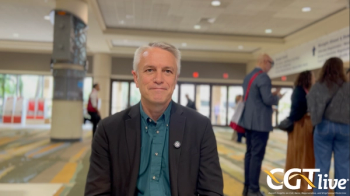
Tandems of Targeted Therapy No Better Than Bevacizumab Alone in Advanced Renal Cell Carcinoma
Combination targeted therapy did not significantly extend progression-free survival compared with single-agent bevacizumab in patients with advanced renal cell carcinoma.
David F. McDermott, MD
Combination targeted therapy did not significantly extend progression-free survival (PFS) compared with single-agent bevacizumab in patients with advanced renal cell carcinoma, according to the results of a randomized phase II trial.
Tandems of bevacizumab/temsirolimus, bevacizumab/sorefenib, and sorafenib/temsirolimus studied in a total of 361 treatment-naïve patients could not improve upon the PFS obtained with bevacizumab alone, reported David F. McDermott, MD, at the 2013 Genitourinary (GU) Cancers Symposium.
Single agents targeting the vascular endothelial growth factor (VEGF) and the mammalian target of rapamycin (mTOR) pathways have improved outcomes for patients with renal cell carcinoma compared with traditional treatment with cytokines. The goal of the phase II trial was to find a combination regimen to take forward for potential comparison to the best available single-agent therapy in a phase III trial.
“The hope was that by targeting more than one pathway at a time, you might be able to enhance the clinical benefit,” said McDermott, director of the Kidney Cancer Program at Dana-Farber/Harvard Cancer Center in Boston, Massachusetts. “The result is interesting and disappointing in that, compared with bevacizumab, the combinations were either not better or not better enough to suggest that they should go further in phase III trials. In addition, compared to single agent, there was more toxicity seen in all of the combinations.”
Patients in the trial were randomized to one of the following regimens:
- Bevacizumab, 10 mg/kg every 2 weeks
- Temsirolimus, 25 mg weekly, plus bevacizumab, 10 mg/kg
- Bevacizumab, 5 mg/kg every 2 weeks, plus sorafenib, 200 mg orally 5 days on/2 days off
- Sorafenib, 200 mg daily, plus temsirolimus, 25 mg weekly
Patients were treated until disease progression or unacceptable toxicity. The study was designed to detect a 67% improvement in median PFS in the combination arms, compared with single-agent bevacizumab.
The combination that was most active was bevacizumab/sorafenib, but the improvement in PFS compared with single-agent bevacizumab did not meet the prespecified criterion for superiority, with a hazard ratio of 0.84 but a 95% confidence interval that exceeded 1 (0.62-1.13; P = .32).
“These agents inhibit two different parts of the VEGF pathway. Bevacizumab binds the protein in circulation and sorafenib blocks the receptor, so that was a rational combination, but it may turn out that there are limits to how much you can block the VEGF pathway with agents that aren’t necessarily that selective,” he said. “It doesn’t mean that you can’t do better than bevacizumab alone; it may mean that you need to get a more targeted agent to combine it with.”
The median PFS in each of the treatment arms was as follows:
- 8.7 months for bevacizumab
- 7.3 months for bevacizumab/temsirolimus
- 11.3 months for bevacizumab/sorafenib
- 7.7 months for sorafenib/temsirolimus
No differences in overall survival were observed.
As expected, grade 3/4 adverse events (hypertension, fatigue, hand-foot syndrome, proteinuria, hypophosphatemia, and hyperglycemia) and dose reductions were more common on combination targeted therapy than with bevacizumab alone.
Combination targeted therapy that incorporates more selective inhibitors of VEGF, such as axitinib and tivozanib, may yield positive results compared with single-agent therapy, believes McDermott. “There is also a subset of patients who clearly benefit from mTOR inhibition, but one question is: Can we identify these patients before we treat them?” he said. “The second [question] is: Can we identify and target pathways that escape mTOR inhibition?” Immunotherapies and inhibitors of angiopoietin 2 represent other options for use in combination therapy.
The GU symposium was co-sponsored by ASCO, the American Society for Radiation Oncology, and the Society of Urologic Oncology.
McDermott DF, Manola J, Pins M, et al. The BEST trial (E2804): a randomized phase II study of VEGF, RAF kinase, and mTOR combination targeted therapy (CTT) with bevacizumab (bev), sorafenib (sor), and temsirolimus (tem) in advanced renal cell carcinoma (RCC). J Clin Oncol. 2013;31(suppl 6): abstr 345.
<<<
Newsletter
Stay at the forefront of cutting-edge science with CGT—your direct line to expert insights, breakthrough data, and real-time coverage of the latest advancements in cell and gene therapy.



































